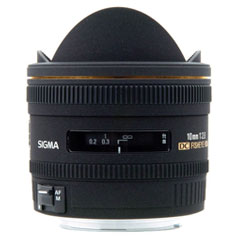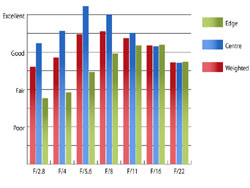Sigma 10mm f/2.8 EX DC HSM Diagonal Fisheye
 |  Professional photographer and expert reviewer checks out Sigma's classy fisheye optic |
A wide aperture diagonal fisheye for APS-C sensor cameras, which offers an angle of view of 180 degrees from corner to corner.
Sigma's 10mm diagonal fisheye has a bright maximum aperture of F/2.8, Hyper Sonic Motor (HSM) focusing and costs around £500 and is available to fit Canon, Nikon and Sigma cameras.
Tokina are currently the only other third party manufacturer offering a diagonal fisheye for APS-C sensors cameras. Their 10-17mm lens also offers a 180 degree angle of view from corner to corner, but also has the flexibility of being a zoom lens. The maximum aperture isn't as bright though.
Canon don't currently offer a fisheye for their EF-S cameras, so this lens may be of special interest to Canon users.Nikon's 10.5mm fisheye costs around £520 and also gives a 180degree field of view on a DX sensor camera. This lens doesn't have a silent focusing motor, but has the same bright maximum aperture as the Sigma lens.
Sigma 10mm f/2.8 EX DC HSM Diagonal Fisheye: Handling and features
For a compact lens, this Sigma 10mm has quite a bit of weight to it. The fit and finish of the lens is very good indeed and the lens barrel and built-in hood are finished in a powder coated effect. A gold ring around the front of the lens barrel signifies that this lens is one of their EX series lenses, which are Sigma's top-line of lenses.
A narrow focus ring is provided for adjusting focus. As the depth of field is so deep with fisheye lenses, I can rarely see I time where the full-time manual override will be necessary. The built in hood is curved at the front, which makes it especially good at keeping unwanted light off the front element, but the curve means it is difficult to place down without the lens cap attached. Most other manufacturers flatten off the front edges of the hood so that the lens doesn't topple over when placed face down. I can see the merit in this design though.
Helped in part by the massive depth-of-field, focusing is swift, precise and virtually silent thanks to the Hyper Sonic Motor.
I found this lens is a joy to use, thanks to its superb build quality.

Sigma 10mm f/2.8 EX DC HSM Diagonal Fisheye: Performance
For this review, the lens was tested on a 10Mp Nikon D80 using Imatest.
For this kind of lens, the sharpness in the centre of the image is surprisingly high at f/2.8, although the quality towards the edges of the frame is only just acceptable. The lens continues to improve at it is stopped down and the best overall quality is achieved at f/8, where the centre resolution is excellent and it is pretty good towards the edges. Stopping down to f/11 will improve the edges further, but diffraction reduces the resolution in the centre of the frame.
Resolution at 10mm

Fisheye lenses are normally prone to chromatic aberrations, especially towards the edges of the frame. This lens is no exception, although the levels of fringing are certainly kept to acceptable levels. Imatest recorded fringing of just below 1 pixel-width towards the edges of the frame.
Chromatic Aberrations at 10mm

Due to the nature of fisheye lenses, it is incredibly difficult to measure light falloff in the corners. In use I only noticed the corners being slightly darker than the image centre at f/2.8 and stopping down to f/5.6 appears to give uniform illumination.
Again, with a fisheye, it is virtually impossible to measure the amount of distortion. The distortion is a characteristic of fisheye lenses, and using a fisheye for normal photography is almost always a creative choice.
Flare and ghosting are kept well under control. Strong point sources of light in the frame will cause a little flare, but contrast in the image appears to preserved well. If you manage to get a light source just outside the frame, the built in hood does a very good job of minimising the associated flare and loss of contrast you would normally expect.
Sigma 10mm f/2.8 EX DC HSM Diagonal Fisheye: Verdict
This lens is a top-class piece of optical design, capable of producing images with very good resolution.
Although the lens is only £20 cheaper than the Nikon equivalent, is does have a silent focusing motor, which means it will focus on Nikon's entry-level bodies and the curved hood design does a very good job of shielding the front element from extraneous light.
As Canon users only have third-party manufacturer's lenses to choose from if they are after a diagonal fisheye for their APS-C sensor camera, this lens is probably the best available in terms of optical quality at the moment.
Sigma 10mm f/2.8 EX DC HSM Diagonal Fisheye: Pros
 Excellent resolution when stopped down
Excellent resolution when stopped down
 Good resolution in the centre at f/2.8
Good resolution in the centre at f/2.8 Chromatic Aberrations kept to acceptable levels
Chromatic Aberrations kept to acceptable levels Build Quality
Build Quality Silent focus motor
Silent focus motorSigma 10mm f/2.8 EX DC HSM Diagonal Fisheye: Cons
 Curved hood makes lens difficult to place down without lens caps
Curved hood makes lens difficult to place down without lens caps| FEATURES |  |
| HANDLING |  |
| PERFORMANCE |  |
| VALUE FOR MONEY |  |
| OVERALL |  |
Sigma 10mm f/2.8 EX DC HSM Diagonal Fisheye: Lens specification
| Price: | £500 |
| Contact: | www.sigma-imaging-uk.com |
| Filter size: | Gel filter holder at rear of lens |
| Format: | APS-C |
| Construction: | 12 elements in 7 groups |
| Angle-of-view: | 180 degrees |
| 35mm equivalent focal length (on APS-C body): | 15 mm |
| Internal focusing: | Yes |
| Image stabilisation: | No |
| Minimum focus: | 13.5cm |
| Maximum aperture: | f/2.8 |
| Minimum aperture: | f/22 |
| Weight: | 475g |
| Size (lxw): | 83mm x 75.8mm |
| In the box: | Padded case |
The Sigma 10mm f/2.8 EX DC HSM Diagonal Fisheye costs £497.99 and is available from Warehouse Express here:
Sigma 10mm f/2.8 EX DC HSM Diagonal Fisheye
Outstanding Fisheye Lens for DX-Format Nikon DSLRs!
First off, bear in mind that I purchased this Sigma fisheye to replace Nikon's 10.5mm f/2.8 fisheye. While I was happy with the Nikon's optical performance, I was disappointed with the AF design. Nikon's lens relies on the AF motor in the camera, which makes for noisy AF. In addition, this design precludes full-time manual focus touch-up. And finally, the lack of an in-lens focus motor precludes AF on the existing D40/D40x and new D60, as well as future Nikon DSLRs lacking an in-camera focus motor.
In any event, when Sigma announced their fisheye lens a few months ago, I decided that I would purchase one. And I am very happy with it! The HSM provides autofocus performance as fast as the Nikon (at least on my Nikon D300 DSLR), while being eerily quiet.
As for the optical quality, it appears to be virtually identical to Nikon's, which is to say excellent. Both lenses are slightly soft wide-open (i.e. at f/2.8), but sharpen considerably when close down one f-stop. Indeed, both lenses are almost as sharp at f/4 as they are at f/5.6.
Besides the built-in autofocus motor, another difference between Nikon and Sigma's fisheye lenses is the field-of-view (FOV). Sigma's lens is 0.5mm wider, and provides a small -- but definitely noticeable -- increase in the angle of view.
http://webcamerawebcamera.com/detail.php?id_detail=Sigma-10mm-f-2-8-EX-DC-HSM-Fisheye-Lens-id69a
First off, bear in mind that I purchased this Sigma fisheye to replace Nikon's 10.5mm f/2.8 fisheye. While I was happy with the Nikon's optical performance, I was disappointed with the AF design. Nikon's lens relies on the AF motor in the camera, which makes for noisy AF. In addition, this design precludes full-time manual focus touch-up. And finally, the lack of an in-lens focus motor precludes AF on the existing D40/D40x and new D60, as well as future Nikon DSLRs lacking an in-camera focus motor.
In any event, when Sigma announced their fisheye lens a few months ago, I decided that I would purchase one. And I am very happy with it! The HSM provides autofocus performance as fast as the Nikon (at least on my Nikon D300 DSLR), while being eerily quiet.
As for the optical quality, it appears to be virtually identical to Nikon's, which is to say excellent. Both lenses are slightly soft wide-open (i.e. at f/2.8), but sharpen considerably when close down one f-stop. Indeed, both lenses are almost as sharp at f/4 as they are at f/5.6.
Besides the built-in autofocus motor, another difference between Nikon and Sigma's fisheye lenses is the field-of-view (FOV). Sigma's lens is 0.5mm wider, and provides a small -- but definitely noticeable -- increase in the angle of view.
http://webcamerawebcamera.com/detail.php?id_detail=Sigma-10mm-f-2-8-EX-DC-HSM-Fisheye-Lens-id69a
Add your message
Login required
Please login here or if you've not registered, you can register here. Registering is safe, quick and free.
Please login here or if you've not registered, you can register here. Registering is safe, quick and free.
photodo Stats
1102 lenses
428 MTF tests
74 in-depth photodo reviews
100+ users join each day
Help the lens community by reviewing or rating a lens today via our lens search
428 MTF tests
74 in-depth photodo reviews
100+ users join each day
Help the lens community by reviewing or rating a lens today via our lens search
Latest Lens Reviews
- Chinon 28mm f/2.8 Vintage Lens Review
- Canon EF 70-200mm f/4L IS II USM Lens Review
- Samyang AF 85mm f/1.4 EF Review
- Sigma 70mm f/2.8 DG Macro Art Review
- Samyang AF 24mm f/2.8 FE Review
- Meike 50mm f/1.7 Review
- Tamron 70-210mm f/4 Di VC USD Review
- Lensbaby Burnside 35mm f/2.8 Review
- Asahi Super Takumar 50mm f/1.4 Review
- Asahi Super-Multi-Coated Takumar 135mm f/3.5 Review
